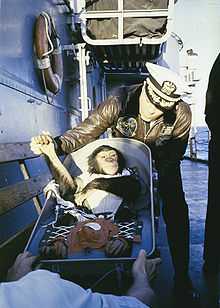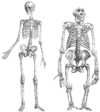Ham (chimpanzee)
.jpg)
Ham (July 1956 – January 19, 1983), also known as Ham the Chimp and Ham the Astrochimp, was a chimpanzee and the first Hominidae launched into space, on 31 January 1961, as part of America's space program. Ham's name is an acronym for the lab which prepared him for his historic mission — the Holloman Aerospace Medical Center, located at Holloman Air Force Base in New Mexico.
Early life
Ham was born in July 1956[1][2]:245 in Cameroon, captured by animal trappers and sent to Rare bird Farm in Miami, Florida.[2]:245 He was purchased by the United States Air Force and brought to Holloman Air Force Base in 1959.[1]
There were originally 40 chimpanzee flight candidates at Holloman. After evaluation the number of candidates was reduced to 18, then to 6, including Ham.[2]:245–246 Officially, Ham was known as No. 65 before his flight, and only renamed "Ham" upon his successful return to earth. This was reportedly because officials did not want the bad press that would come from the death of a "named" chimpanzee if the mission were a failure.[3] Among his handlers, No.65 had been known as Chop Chop Chang.[4][5]
Training and mission

Beginning in July 1959, the three-year-old chimpanzee was trained under the direction of neuroscientist Joseph V. Brady at Holloman Air Force Base Aero Medical Field Laboratory to do simple, timed tasks in response to electric lights and sounds.[6] In his pre-flight training, Ham was taught to push a lever within five seconds of seeing a flashing blue light; failure to do so resulted in an application of positive punishment in the form of a mild electric shock to the soles of his feet, while a correct response earned him a banana pellet.[7]:243
What differentiates Ham's mission from all the other primate flights to this point is that he was not merely a passenger, and the results from his test flight led directly to the mission Alan Shepard made on May 5, 1961 aboard Freedom 7.
On January 31, 1961, Ham was secured in a Project Mercury mission labeled MR-2 and launched from Cape Canaveral, Florida, on a suborbital flight.[7]:314–315 Ham had his vital signs and tasks monitored using computers on Earth.[8] The capsule suffered a partial loss of pressure during the flight, but Ham's space suit prevented him from suffering any harm.[7]:315 Ham's lever-pushing performance in space was only a fraction of a second slower than on Earth, demonstrating that tasks could be performed in space.[7]:316 Ham's capsule splashed down in the Atlantic Ocean and was recovered by a rescue ship later that day.[7]:316 He only suffered a bruised nose.[8] His flight was 16 minutes and 39 seconds long.[9]
Later life

After the flight, Ham lived for 17 years in the National Zoo in Washington, D.C.[2]:255–257
After his death in 1983, Ham's body was turned over to the Armed Forces Institute of Pathology for necropsy. Following the necropsy, the plan was to have him stuffed and placed on display at the Smithsonian, following Soviet precedent with pioneering space dogs Belka and Strelka. However, this plan was abandoned after a negative public reaction. Ham's remains, minus the skeleton, were buried at the International Space Hall of Fame in Alamogordo, New Mexico. Colonel John Stapp gave the eulogy at the memorial service.[10] The skeleton is held in the collection of the National Museum of Health and Medicine.[11]
Ham's backup, Minnie, was the only female chimp trained for the Mercury program. After her role in the Mercury program ended, Minnie became part of an Air Force chimpanzee breeding program, producing nine offspring and helping to raise the offspring of several other members of the chimpanzee colony.[2]:258–259 The last surviving astro-chimp, she died at age 41 on March 14, 1998.[2]:259
Popular culture
- In 2000, in the film Space Cowboys, the main characters Frank Corvin (Clint Eastwood), Hawk Hawkins (Tommy Lee Jones) and their team Daedalus of the U.S. Air Force are replaced by a chimpanzee named Mary-Ann for the new civilian organization (NASA) to take control of the new external atmosphere exploration program. The film mentions that the chimp became the first American to cross into outer space.[12]
- A 2001 film titled Race to Space, was a fictionalized version of Ham's story about sending chimps to space. The chimpanzee in the movie was named Mac.[13]
- In series 1, episode 11 of The Ricky Gervais Show, Karl Pilkington tells his version of Ham's mission in his "Monkey News" segment.
- The 2006 song "Monkey 61" by Irish band Bell X1 was based on Ham the Chimp.
- In 2006, a documentary was made for Animal Planet called "Astrochimp #65" which tells the story of Ham as witnessed by Jeff. Jeff took care of Ham until his departure from the Air Force Base after the success of the mission.
- A 2008 animated film entitled Space Chimps was about sending chimps to space. The main character and hero of the movie was named Ham III, the grandson of Ham.[14]
- In 2008, Bark Hide & Horn, a folk-rock band from Portland, Oregon, released a song titled, "Ham the Astrochimp," detailing the journey of Ham from his perspective.[15]
- Curious George, the popular character from the children's books of the same name, undertakes a similar mission in the story Curious George Gets a Medal, published four years before Ham's flight.
- In the 1983 film adaption of The Right Stuff, the launch and splashdown of Ham's space flight is dramatized. The Mercury astronauts are asked by the traveling press corps which one thinks they will be first into space. After a montage showing the first successful launch and ocean recovery of a mission rocket, it is revealed that Ham the Chimp is the first "American" in space.
See also
- On November 29, 1961, a chimp named Enos orbited the earth on board Mercury Atlas 5.[7]:404
- Animals in space
- Monkeys and apes in space
- One Small Step: The Story of the Space Chimps (2008 documentary)
References
- ↑ 1.0 1.1 Gray, Tara (1998). "A Brief History of Animals in Space". National Aeronautics and Space Administration. Retrieved 2008-05-12.
- ↑ 2.0 2.1 2.2 2.3 2.4 2.5 Burgess, Colin; Chris Dubbs (2007) [2007-01-24]. Animals in Space: From Research Rockets to the Space Shuttle. Springer-Praxis Books in Space Exploration. Springer. ISBN 978-0-387-36053-9. OCLC 77256557.
- ↑ Haraway, Donna. Primate Visions: Gender, Race, and Nature in the World of Modern Science (New York: Routledge, 1989).
- ↑ Haraway, Donna. Primate Visions: Gender, Race, and Nature in the World of Modern Science (New York: Routledge, 1989), 138.
- ↑ "The Nearest Thing", Time, 10 February 1961.
- ↑ House, George (April–June 1991). "Project Mercury's First Passengers". Spacelog (Alamogordo, New Mexico: International Space Hall of Fame Foundation) 8 (2): 4–5. ISSN 1072-8171. OCLC 18058232.
- ↑ 7.0 7.1 7.2 7.3 7.4 7.5 Swenson Jr., Loyd S.; James M. Grimwood; Charles C. Alexander (1966). This New Ocean: A History of Project Mercury. NASA History Series. National Aeronautics and Space Administration. OCLC 00569889. Retrieved 2008-05-11.
- ↑ 8.0 8.1 Margaret G. Zackowitz (October 2007). "The Primate Directive". National Geographic Magazine. Archived from the original on 2007-11-12. Retrieved 2008-04-30.
- ↑ . "NASA Project Mercury Mission MR-2". National Aeronautics and Space Administration. Retrieved 2008-05-11.
- ↑ Roach, Mary (2010). Packing for Mars: The Curious Science of Life in the Void. Norton. pp. 160–163. ISBN 0393068471.
- ↑ Nicholls, Henry (7 February 2011). "Cameroon's Gagarin: The Afterlife of Ham the Astrochimp".
- ↑ Space Cowboys at the Internet Movie Database
- ↑ Race to Space at the Internet Movie Database
- ↑ Space Chimps at the Internet Movie Database
- ↑ http://www.portlandmercury.com/music/for-melville-with-love/Content?oid=868635
Further reading
- Farbman, Melinda; Frye Gaillard (June 2000) [2000]. Spacechimp: NASA's Ape in Space. Countdown to Space. Berkeley Heights, NJ: Enslow Publishers. ISBN 978-0-7660-1478-7. OCLC 42080118. Brief biography of Ham, aimed at children ages 9–12
- Rosenstein, Andrew (July 2008). Flyboy: The All-True Adventures of a NASA Space Chimp. Windham, ME: Yellow Crane Press. ISBN 978-0-9758825-2-8. A novel about Ham and his trainer.
- Burgess, Colin; Dubbs, Chris. Animals in Space: From Research Rockets to the Space Shuttle. Springer-Praxis Books, ISBN 978-0-387-36053-9. Book covering the life and flight of Ham, plus other space animals.
External links
| Wikimedia Commons has media related to Ham the Chimp. |
- Pictures from the NASA Life Sciences Data Archive
- Who2 profile: Ham the Chimp
- Animal Astronauts
- Ham at Findagrave.com
- Trailblazer in Space Newsreel/Documentary about Ham at archive.org
- In Praise of Ham the Astrochimp in LIFE
| ||||||||||||||||||||
